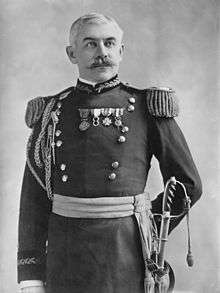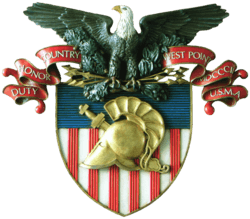Thomas Henry Barry
| Thomas Henry Barry | |
|---|---|
 Major General Thomas Henry Barry | |
| Born |
October 13, 1855 New York City |
| Died |
December 30, 1919 (aged 64) Washington, D.C. |
| Allegiance |
|
| Service/branch |
|
| Years of service | 1877–1919 |
| Rank |
|
| Commands held |
Superintendent of the United States Military Academy Department of the East Philippine Department 86th Infantry Division |
| Awards |
Distinguished Service Medal Silver Star |
Thomas Henry Barry (October 13, 1855 – December 30, 1919) was a United States Army Major General and Superintendent of the United States Military Academy from 1910 to 1912.[1]
Early life
Barry was born in a small frame house at 24 Thames Street, near Trinity Place, in Lower Manhattan. He played baseball in Battery Park as a young boy. He received his early education in the public schools and the Free Academy of the City of New York. He graduated from West Point in 1877.[1]
Military career
Barry was assigned as a Second Lieutenant to the 7th Cavalry Regiment on June 14, 1877. In 1880 he was transferred to the 1st Infantry.[2] He was appointed Assistant Adjutant General of the army in 1893. He was a Lieutenant Colonel during the Spanish–American War. He was also Adjutant General of the 8th Army Corps during the war. He was appointed Brigadier General of volunteers after a brief period as Adjutant General of the army.[1] As a Brigadier General of volunteers he served in the China Relief Expedition and in the Philippine-American War during 1900–1901. He became a Brigadier General in August 1903.[2] At the start of the Russo-Japanese War of 1904-1905, he was assigned to the Imperial Russian Army as a military observer.[3]
In 1907, he was chosen as commander for the Army of Cuban Occupation and Pacification by President Theodore Roosevelt. He was promoted to Major General on April 29, 1908. He became Superintendent of the United States Military Academy on August 31, 1910.[4] He was succeeded by Clarence Page Townsley as Superintendent of the Academy on August 31, 1912.[2] He was assigned to command the Eastern Division of the US Army for the next two years. In 1914 he was sent to the Philippines and China as commander of all the American troops. He was retired on October 13, 1919.[1]

Death
Barry died of uremic poisoning as the result of Bright's disease at Walter Reed Army Medical Center on December 30, 1919.[1] He had been ill for three weeks.[1][5]
Legacy
- Army transport Thomas H. Barry.[6]
References
- 1 2 3 4 5 6 "General T. H. Barry Dies In Washington" (PDF). The New York Times. 1919-12-31. Retrieved 2009-04-25.
Major Gen. Thomas Henry Barry, U.S.A., retired, died early this morning from uraemic poisoning at the Walter Reed General Army Hospital, near Washington, where he had been ill three weeks, a sufferer from Bright's disease. Mrs. Barry and their son, Major Thomas B. Barry, were with General Barry when he died.
- 1 2 3 "Gen. Barry In Grant's Place. West Point Head to Command Eastern Division of Army." (pdf). The New York Times. August 17, 1912. Retrieved 2009-07-26.
Major Gen. Thomas H. Barry, U.S.A., Superintendent of the Military Academy at West Point, has been assigned to command the Eastern Division, with headquarters in New York, succeeding the late Major Gen. Frederick D. Grant.
- ↑ Kowner, Rotem (2006). Historical Dictionary of the Russo-Japanese War. ISBN 0-8108-4927-5: The Scarecrow Press. pages 61-62
- ↑ "New Yorker Takes Charge At West Point. Maj. Gen. Thomas H. Barry the Second of His Rank to Be Superintendent." (pdf). The New York Times. August 28, 1910. Retrieved 2009-07-26.
Major Gen. Thomas H. Barry, U.S.A., who becomes Superintendent of the United States Military Academy at West Point on Sept. 1 ...
- ↑ "Gen. T. H. Barry Dies In East. Ill 3 Weeks". Chicago Tribune. December 31, 1919. Retrieved 2009-07-28.
Commanded Camp Grant. Retired but Recently.
- ↑ "Thomas H. Barry Carries 474, Including General Muller". New York Times. December 12, 1947. Retrieved 2009-07-28.
The Army transport Thomas H. Barry arrived here yesterday and docked at Pier 11, Staten Island, with 474 passengers after a stormy fourteen-day voyage from ...
External links
- Cullum, George Washington (1920) [1868]. Robinson, Wirt, ed. Biographical Register of the Officers and Graduates of the United States Military Academy...: Supplement (1910–1920). 2679. VI–A. Edward Singleton Holden, Charles Braden (3 ed.). Saginaw, Michigan: Houghton Mifflin. p. 236. Retrieved August 7, 2009.
- Cullum, George Washington (1901) [1868]. Braden, Charles, ed. Biographical Register of the Officers and Graduates of the United States Military Academy. 2679. V (3 ed.). Saginaw, Michigan: Houghton Mifflin. pp. 261–262. Retrieved August 7, 2009.
- Cullum, George Washington (1891) [1868]. Holden, Edward Singleton, ed. Biographical Register of the Officers and Graduates of the United States Military Academy. 2679. III (3 ed.). Cambridge, Massachusetts: Houghton Mifflin. p. 283. Retrieved August 7, 2009.
- Cullum, George Washington (1901) [1868]. Holden, Edward Singleton, ed. Biographical Register of the Officers and Graduates of the United States Military Academy...: Supplement (1890–1900). 2679. IV. Saginaw, Michigan: Houghton Mifflin. pp. 284–285. Retrieved August 7, 2009.
- McIver, George Willcox (2006). Jonathan Dembo, ed. A Life of Duty: the autobiography of George Willcox McIver, 1858-1948. The History Press. p. 177. ISBN 1-59629-028-5. Retrieved August 7, 2009.
- Roosevelt, Theodore (1916). Theodore Roosevelt; An Autobiography (3 ed.). MacMillan. p. 47. Retrieved August 7, 2009.
- United States Geological Survey (1901). Bulletin of the United States Geological Survey No. 185. F, Geography 26. Washington, D.C.: Government Printing Office. p. 88. Retrieved August 7, 2009.
- The World Almanac and Encyclopedia. New York City: Press Publishing (New York World). 1906. p. 423. Retrieved August 7, 2009.
| Military offices | ||
|---|---|---|
| Preceded by Hugh L. Scott |
Superintendents of the United States Military Academy 1910–1912 |
Succeeded by Clarence Page Townsley |
